Tali Keren
Tali Keren is a multi-disciplinary artist and educator based in New York. Her performances, videos, and installations focus on the formation of ideology, settler-colonial violence, and political identity. Since moving to the United States, she has explored USA/Israel/Palestine relations through the intersection of religion, politics, and militarization.
Keren’s recent solo exhibitions include Heat Signature at Ludlow 38, MINI Goethe Institute, New York. The Great Seal at Eyebeam, New York, and the Center for Contemporary Art, Tel Aviv. Her first museum solo exhibition opens in early 2021 at the Museum of Contemporary Art Detroit (MOCAD).
Her work has been exhibited and performed at Anthology Film Archives, New York; the Museum of the Moving Image, New York; the Whitney Museum of American Art, New York; Socrates Sculpture Park, New York; the Jewish Museum, New York; Museums Quartier, Vienna; Kunsthal Charlottenborg, Copenhagen; the Israeli Center for Digital Art, Holon; Herzliya Museum of Contemporary Art; and in New York City’s Times Square. Keren received her BFA in 2009 from the Bezalel Academy of Art and Design, Jerusalem, and earned an MFA from Columbia University, in New York, in 2016. She was an artist in residence at ISCP, NARS Foundation, and BRICworkspace, New York.
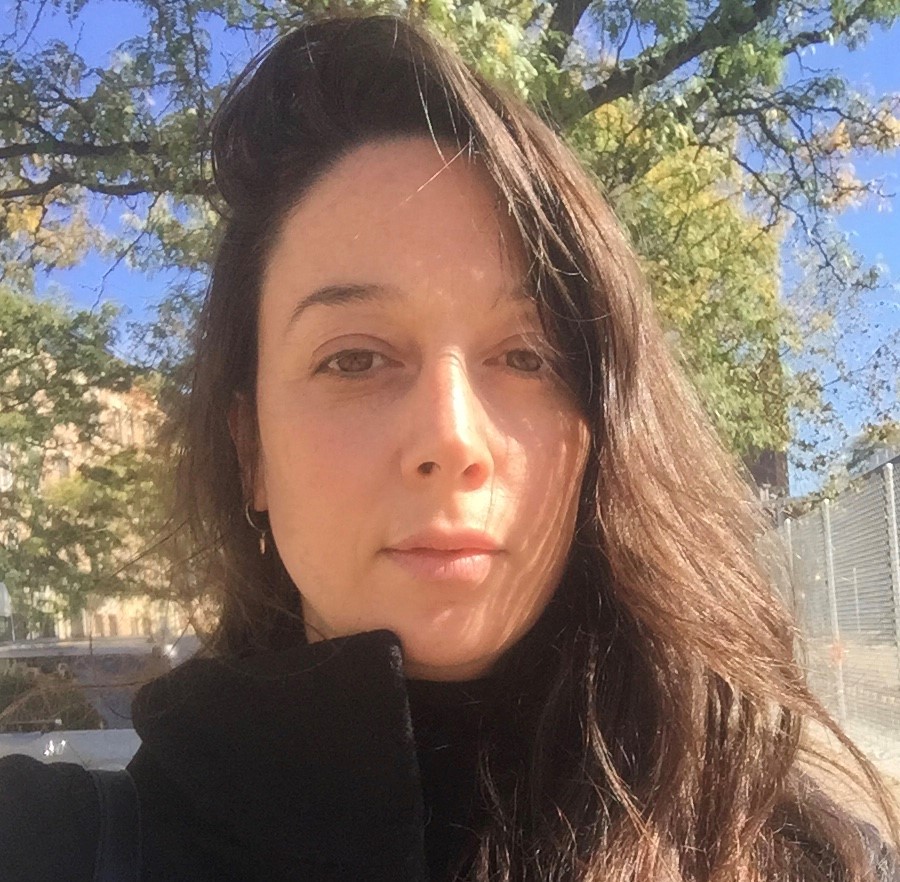
Works
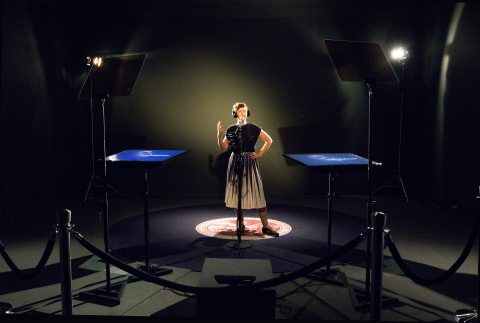
The Great Seal
Interactive installation/performanceThis immersive installation investigates the intersection between art, propaganda, religion, and politics. The piece invites viewers to step onto a stage at the annual Washington D.C. Summit of Christians United for Israel (CUFI) and assume the role of keynote speakers. CUFI mobilizes millions of American Evangelical conservatives who view Jewish rule over the land of Israel/Palestine a precondition for Christ’s second coming and the imminent Battle of Armageddon. By using a presidential teleprompter and a karaoke ‘sing-along’ machine, participants are invited to perform speeches compiled from those delivered at past CUFI summits.
Throughout the interactive performance, the visitors will stand on a rug emblazoned with the design for the original Great Seal of the United States, first proposed by Benjamin Franklin and Thomas Jefferson in 1776, and subsequently rejected by Congress. Franklin and Jefferson’s Great Seal reimagines the...
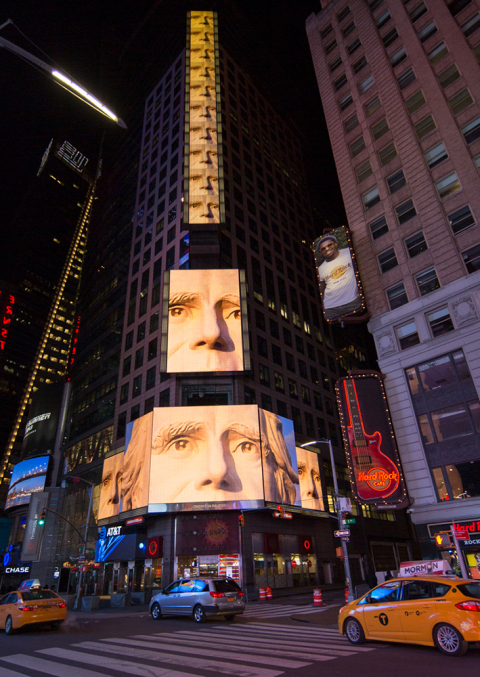
Save the Presidents
Video installation, collaboration with Alex StradaSave the Presidents is a film that focuses on the deterioration of forty-three monumental sculptures of former American Presidents situated in a field in rural Virginia. Structured over the course of a day, the work begins with the presidents sitting drenched in the morning sunlight as manual laborers arrive at the field for work. As the light wanes and the laborers leave, the presidents are left alone to watch the sunset fade to black. The film explores the promise and instability of political mythology while raising questions about depictions of democracy, whiteness, and gender
Every evening throughout February 2018, a shortened version of Save the Presidents took over the screens of Times Square at midnight as part of Times Square Arts’ Midnight Moment. The film transformed the Morgan Stanley Building, NASDAQ Tower, Microsoft Cube, and over 50 other branded screens in...
Read more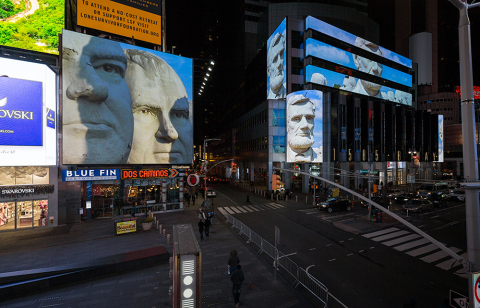
Save the Presidents
Video installation, collaboration with Alex StradaSave the Presidents is a film that focuses on the deterioration of forty-three monumental sculptures of former American Presidents situated in a field in rural Virginia. Structured over the course of a day, the work begins with the presidents sitting drenched in the morning sunlight as manual laborers arrive at the field for work. As the light wanes and the laborers leave, the presidents are left alone to watch the sunset fade to black. The film explores the promise and instability of political mythology while raising questions about depictions of democracy, whiteness, and gender
Every evening throughout February 2018, a shortened version of Save the Presidents took over the screens of Times Square at midnight as part of Times Square Arts’ Midnight Moment. The film transformed the Morgan Stanley Building, NASDAQ Tower, Microsoft Cube, and over 50 other branded screens in...
Read more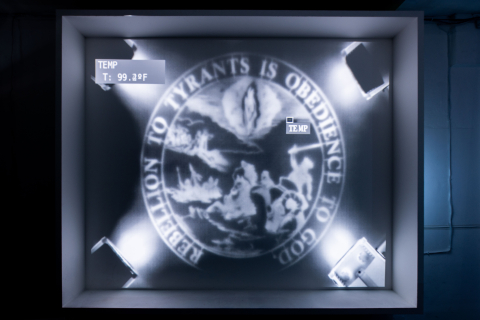
Heat Signature
Mixed media installationThis site-specific installation looks at the connections between Judeo-Christian ideology and the military-industrial complex. The piece juxtaposes Jefferson’ and Franklin’s unsuccessful proposal for the Great Seal of the United States with a military-grade thermal camera manufactured by FLIR Systems, Inc. Doing so, the work underscores inherent relations between American national myths, religious beliefs, and quests for power and control. In Heat Signature, Jefferson and Franklin’s rejected design, which depicts the biblical story of the Israelites’ exodus from Egypt with America serving as the “New Zion,” is brought to life with an infrared camera and electric heaters. As the heaters turn on and off and the image of the Seal, which is embedded in the ceiling—unseen to the eye—heats and cools appears and disappears. Testimonies by a drone sensor operator, a criminal defense attorney, and a media scholar—voices reflecting on the ethical, racial, and legal issues of a temperature-based visual regime—are presented in three audio-recorded interviews.
Read more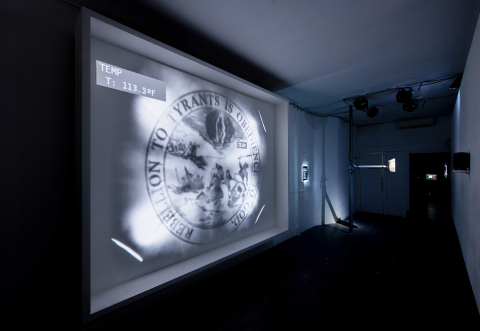
Heat Signature
Mixed media installationThis site-specific installation looks at the connections between Judeo-Christian ideology and the military-industrial complex. The piece juxtaposes Jefferson’ and Franklin’s unsuccessful proposal for the Great Seal of the United States with a military-grade thermal camera manufactured by FLIR Systems, Inc. Doing so, the work underscores inherent relations between American national myths, religious beliefs, and quests for power and control. In Heat Signature, Jefferson and Franklin’s rejected design, which depicts the biblical story of the Israelites’ exodus from Egypt with America serving as the “New Zion,” is brought to life with an infrared camera and electric heaters. As the heaters turn on and off and the image of the Seal, which is embedded in the ceiling—unseen to the eye—heats and cools appears and disappears. Testimonies by a drone sensor operator, a criminal defense attorney, and a media scholar—voices reflecting on the ethical, racial, and legal issues of a temperature-based visual regime—are presented in three audio-recorded interviews.
Read more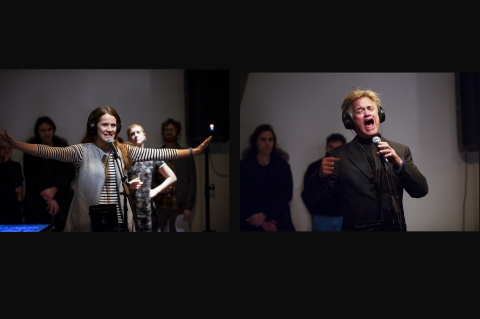
The Great Seal
Interactive installation/performanceThis immersive installation investigates the intersection between art, propaganda, religion, and politics. The piece invites viewers to step onto a stage at the annual Washington D.C. Summit of Christians United for Israel (CUFI) and assume the role of keynote speakers. CUFI mobilizes millions of American Evangelical conservatives who view Jewish rule over the land of Israel/Palestine a precondition for Christ’s second coming and the imminent Battle of Armageddon. By using a presidential teleprompter and a karaoke ‘sing-along’ machine, participants are invited to perform speeches compiled from those delivered at past CUFI summits.
Throughout the interactive performance, the visitors will stand on a rug emblazoned with the design for the original Great Seal of the United States, first proposed by Benjamin Franklin and Thomas Jefferson in 1776, and subsequently rejected by Congress. Franklin and Jefferson’s Great Seal reimagines the...
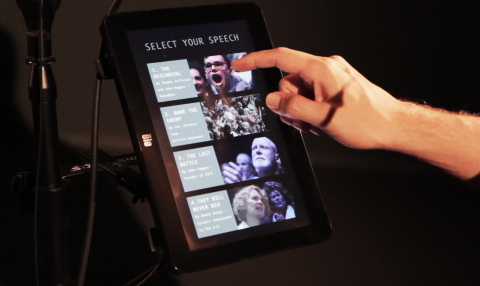
The Great Seal
Interactive installation/performanceThis immersive installation investigates the intersection between art, propaganda, religion, and politics. The piece invites viewers to step onto a stage at the annual Washington D.C. Summit of Christians United for Israel (CUFI) and assume the role of keynote speakers. CUFI mobilizes millions of American Evangelical conservatives who view Jewish rule over the land of Israel/Palestine a precondition for Christ’s second coming and the imminent Battle of Armageddon. By using a presidential teleprompter and a karaoke ‘sing-along’ machine, participants are invited to perform speeches compiled from those delivered at past CUFI summits.
Throughout the interactive performance, the visitors will stand on a rug emblazoned with the design for the original Great Seal of the United States, first proposed by Benjamin Franklin and Thomas Jefferson in 1776, and subsequently rejected by Congress. Franklin and Jefferson’s Great Seal reimagines the...

The Great Seal
Interactive installation/performanceThis immersive installation investigates the intersection between art, propaganda, religion, and politics. The piece invites viewers to step onto a stage at the annual Washington D.C. Summit of Christians United for Israel (CUFI) and assume the role of keynote speakers. CUFI mobilizes millions of American Evangelical conservatives who view Jewish rule over the land of Israel/Palestine a precondition for Christ’s second coming and the imminent Battle of Armageddon. By using a presidential teleprompter and a karaoke ‘sing-along’ machine, participants are invited to perform speeches compiled from those delivered at past CUFI summits.
Throughout the interactive performance, the visitors will stand on a rug emblazoned with the design for the original Great Seal of the United States, first proposed by Benjamin Franklin and Thomas Jefferson in 1776, and subsequently rejected by Congress. Franklin and Jefferson’s Great Seal reimagines the...

Save the Presidents
Video installation, collaboration with Alex StradaSave the Presidents is a film that focuses on the deterioration of forty-three monumental sculptures of former American Presidents situated in a field in rural Virginia. Structured over the course of a day, the work begins with the presidents sitting drenched in the morning sunlight as manual laborers arrive at the field for work. As the light wanes and the laborers leave, the presidents are left alone to watch the sunset fade to black. The film explores the promise and instability of political mythology while raising questions about depictions of democracy, whiteness, and gender
Every evening throughout February 2018, a shortened version of Save the Presidents took over the screens of Times Square at midnight as part of Times Square Arts’ Midnight Moment. The film transformed the Morgan Stanley Building, NASDAQ Tower, Microsoft Cube, and over 50 other branded screens in...
Read more
Save the Presidents
Video installation, collaboration with Alex StradaSave the Presidents is a film that focuses on the deterioration of forty-three monumental sculptures of former American Presidents situated in a field in rural Virginia. Structured over the course of a day, the work begins with the presidents sitting drenched in the morning sunlight as manual laborers arrive at the field for work. As the light wanes and the laborers leave, the presidents are left alone to watch the sunset fade to black. The film explores the promise and instability of political mythology while raising questions about depictions of democracy, whiteness, and gender
Every evening throughout February 2018, a shortened version of Save the Presidents took over the screens of Times Square at midnight as part of Times Square Arts’ Midnight Moment. The film transformed the Morgan Stanley Building, NASDAQ Tower, Microsoft Cube, and over 50 other branded screens in...
Read more
Heat Signature
Mixed media installationThis site-specific installation looks at the connections between Judeo-Christian ideology and the military-industrial complex. The piece juxtaposes Jefferson’ and Franklin’s unsuccessful proposal for the Great Seal of the United States with a military-grade thermal camera manufactured by FLIR Systems, Inc. Doing so, the work underscores inherent relations between American national myths, religious beliefs, and quests for power and control. In Heat Signature, Jefferson and Franklin’s rejected design, which depicts the biblical story of the Israelites’ exodus from Egypt with America serving as the “New Zion,” is brought to life with an infrared camera and electric heaters. As the heaters turn on and off and the image of the Seal, which is embedded in the ceiling—unseen to the eye—heats and cools appears and disappears. Testimonies by a drone sensor operator, a criminal defense attorney, and a media scholar—voices reflecting on the ethical, racial, and legal issues of a temperature-based visual regime—are presented in three audio-recorded interviews.
Read more
Heat Signature
Mixed media installationThis site-specific installation looks at the connections between Judeo-Christian ideology and the military-industrial complex. The piece juxtaposes Jefferson’ and Franklin’s unsuccessful proposal for the Great Seal of the United States with a military-grade thermal camera manufactured by FLIR Systems, Inc. Doing so, the work underscores inherent relations between American national myths, religious beliefs, and quests for power and control. In Heat Signature, Jefferson and Franklin’s rejected design, which depicts the biblical story of the Israelites’ exodus from Egypt with America serving as the “New Zion,” is brought to life with an infrared camera and electric heaters. As the heaters turn on and off and the image of the Seal, which is embedded in the ceiling—unseen to the eye—heats and cools appears and disappears. Testimonies by a drone sensor operator, a criminal defense attorney, and a media scholar—voices reflecting on the ethical, racial, and legal issues of a temperature-based visual regime—are presented in three audio-recorded interviews.
Read more
The Great Seal
Interactive installation/performanceThis immersive installation investigates the intersection between art, propaganda, religion, and politics. The piece invites viewers to step onto a stage at the annual Washington D.C. Summit of Christians United for Israel (CUFI) and assume the role of keynote speakers. CUFI mobilizes millions of American Evangelical conservatives who view Jewish rule over the land of Israel/Palestine a precondition for Christ’s second coming and the imminent Battle of Armageddon. By using a presidential teleprompter and a karaoke ‘sing-along’ machine, participants are invited to perform speeches compiled from those delivered at past CUFI summits.
Throughout the interactive performance, the visitors will stand on a rug emblazoned with the design for the original Great Seal of the United States, first proposed by Benjamin Franklin and Thomas Jefferson in 1776, and subsequently rejected by Congress. Franklin and Jefferson’s Great Seal reimagines the...

The Great Seal
Interactive installation/performanceThis immersive installation investigates the intersection between art, propaganda, religion, and politics. The piece invites viewers to step onto a stage at the annual Washington D.C. Summit of Christians United for Israel (CUFI) and assume the role of keynote speakers. CUFI mobilizes millions of American Evangelical conservatives who view Jewish rule over the land of Israel/Palestine a precondition for Christ’s second coming and the imminent Battle of Armageddon. By using a presidential teleprompter and a karaoke ‘sing-along’ machine, participants are invited to perform speeches compiled from those delivered at past CUFI summits.
Throughout the interactive performance, the visitors will stand on a rug emblazoned with the design for the original Great Seal of the United States, first proposed by Benjamin Franklin and Thomas Jefferson in 1776, and subsequently rejected by Congress. Franklin and Jefferson’s Great Seal reimagines the...

The Great Seal
Interactive installation/performanceThis immersive installation investigates the intersection between art, propaganda, religion, and politics. The piece invites viewers to step onto a stage at the annual Washington D.C. Summit of Christians United for Israel (CUFI) and assume the role of keynote speakers. CUFI mobilizes millions of American Evangelical conservatives who view Jewish rule over the land of Israel/Palestine a precondition for Christ’s second coming and the imminent Battle of Armageddon. By using a presidential teleprompter and a karaoke ‘sing-along’ machine, participants are invited to perform speeches compiled from those delivered at past CUFI summits.
Throughout the interactive performance, the visitors will stand on a rug emblazoned with the design for the original Great Seal of the United States, first proposed by Benjamin Franklin and Thomas Jefferson in 1776, and subsequently rejected by Congress. Franklin and Jefferson’s Great Seal reimagines the...